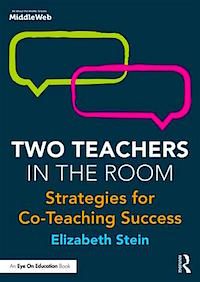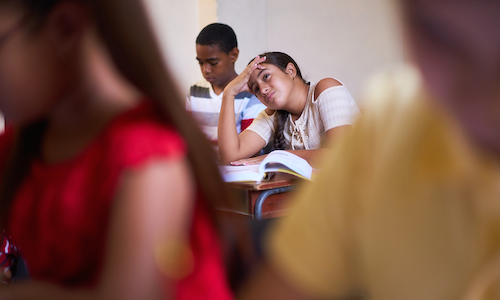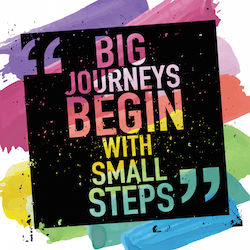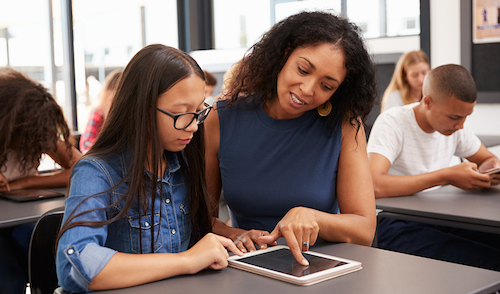Captivating Co-Teaching: Engagement & Feedback
A MiddleWeb Blog
 What part do emotions play in the learning process?
What part do emotions play in the learning process?
How can co-teachers embed social emotional learning strategies and structures to strengthen learning experiences?
How can co-teachers cultivate self-regulated learners?
These essential questions can help co-teachers sharpen their focus as they collaborate on techniques to captivate and engage all their learners. Let’s take a look at the relationship between emotions and learning – and how we can weave what research tells us into practical teaching strategies.
Emotions are a natural part of the learning process
In general, society has separated emotions from cognition. Traditionally, emotions have been treated as a construct that should be kept silent and contained in order to make way for more rational, cognitive thinking skills (Meyer, Rose, & Gordon, 2014).
In recent years, research about emotional awareness within learning environments has provided a deeper understanding of the role that emotions play in positively impacting the learning process.
- Loia and Senatore (2014) found that identifying emotional states within textual information guides readers to adapt their thinking to create a positive influence on their decision making processes.
- Pekrun et al. (2011) demonstrated that emotions, such as anxiety, pride, anger, hope, relief, and boredom, greatly impact students’ thinking and information processing.
Let’s pause here. Think about your classroom experiences. Those students who demonstrate clear boredom and indifference, or excitement and anticipation, set the stage for the amount of information they will perceive and make meaningful. The students who are bored have made the decision to stay detached. Sure, teachers can influence and hopefully redirect – yet there’s even more teachers can do.
Kordaki, Siempos, and Daradoumis (2011) claimed students’ performance increased when teachers provided affective feedback and actually highlighted emotional awareness within a safe, student-centered, constructivist approach to learning.
Teacher comments included “What do you think about . . .” and “What do you think the next step should be?” Affective feedback could be a powerful statement like, “I notice your mind seems to be somewhere else . . . what can we do to help you refocus on this class assignment?”
Providing specific, mastery-oriented feedback is also an important part of the process in blending emotions with cognitive tasks. Rosenshine (1997) supported the presence of increased student learning when teachers implemented a blending of cognitive and collaborative learning strategies within a student-centered learning environment.
Avoiding “rule-bound, flat, vapid” classrooms
In an interview with Education Week (7/18/14), David Rose, co-founder of the Center for Applied Specialized Technology (CAST), shared how the Universal Design for Learning guides educators to cultivate the necessary emotional side of learning. In thinking about classrooms for the present and the future, Rose said:
I hope classrooms will have more emotion in them. That is, you’d see kids excited about learning, you’d see kids arguing various points, you’d see them questioning propositions. You’d see the stuff that really makes learning happen as opposed to the passivity we often see now. So many schools today are rule-bound, flat, vapid places. And everything we know about neuroscience tells us that that’s not a good way to learn.
Co-teachers can easily consider ways to ramp up the learning in their classroom and address the natural variability among diverse populations of students by creating the space for emotions as a natural part of their instructional cycle. Teachers who say, “There’s no time for that,” simply need to take a step back and reflect on the evidence that emotions are present in the learning process naturally.
It comes down to the basic question: Would you rather have an emotional environment where students are passive, bored, detached – or where they are learners who express excitement, engagement, and wonder, demonstrating an active role in their learning process?
The question is not whether there is time for emotions in learning. The question is simply: What range of emotions will you make the time for as you design and execute meaningful learning experiences with your students?
One way to organically blend emotions into the instructional mix is by providing affective feedback. Here are some ways to do that!
Tips for Blending Emotions With Feedback
◆◆ Be Specific: Co-teachers can work together to be objective listeners for one another. If you hear one of you saying, “Great job!” or “No, your response does not answer the question,” send out the flashing weak-feedback alerts!
Gently support one another to fine-tune and extract the most value from giving feedback. Make time to connect with each other outside of class to guide one another to provide more specific feedback: “Great job—you found meaningful text evidence to support the theme.” Or: “You’re on the right track! What part of your answer begins to respond to the question? What other details do you think you could add?”
As you and your co-teacher develop a strong relationship, you may even provide specific feedback to one another in the moment! Why wait to discuss outside of class? Jot down a note and discreetly pass it along. You can also create a feedback code that only you and your co-teacher will understand. It could be a symbol or word that reminds each of you – in the moment – to provide specific feedback with your students.
Beginning feedback with “I notice . . .” is a powerful way to let your students know that their efforts and thoughts are valued – it can be very motivating and spark them to keep going!
◆◆ Be Timely: Make the most of the moments – timely feedback plays a key role in a student’s ability to meaningfully learn and transfer knowledge and skills within the processes of learning from mistakes and celebrating successes.
◆◆ Highlight Progress Toward Goals: Remember the value of feeling successful along the way; it provides motivation for persisting through the process. In addition, learners need to remember the value of actively participating. They need to know why their efforts matter. Talk about creating resilient learners!
◆◆ Encourage Autonomy: Respect and cultivate abilities and capabilities. No hovering! Balance your genuine desire to nurture a self-directed learner. Feedback that is too frequent may adversely affect the students’ self-esteem, confidence, and independence.
◆◆ Include Students in the Feedback Process: When students are a part of evaluating their performance, they develop a keen self-awareness of their learning behaviors that are successful, so they may repeat them. They also are able to view their mistakes as a natural part of the process – and they respond effectively with strategies that help them to grapple with obstacles along the way.
Co-teachers can expand the feedback process by inviting students to provide peer feedback in ways that focus on growth in a non-evaluative, non-judgmental manner. It’s a win-win-win!
◆◆ Give an Example: Have peers work together to provide peer support and modeling. Students of all abilities are capable of being in a peer modeling position. If a student requires one-on-one support with a teacher following the teacher modeling, have that student, in turn, be a peer tutor to model for another peer. It’s an inspiring way to create a strengths-based view of the learners in your room.
◆◆ Be Sensitive to Unique Needs and Keep Variability in Mind: In an inclusive setting, the variability of diverse learners is omnipresent. Co-teachers must remain mindful of this and provide additional supports as needed.
Dinham (2007) identified four questions that will help teachers to provide quality student feedback:
- What can the student do?
- What can’t the student do?
- How does the student’s work compare to grade level expectations and peers?
- What does the student need to do better?

Gregory is able to read through the word problem and identify the mathematical operations needed to solve the problem, but he has difficulty remembering his basic computational facts. He needs to build on his ability in mathematical logical thinking to gain a stronger foundation for basic math facts.
If Gregory was given a calculator, he would be fine. But that access is not always permissible. Gregory must strengthen his basic computation skills. Thinking with a UDL mindset, co-teachers can design the environment to support Gregory. If a calculator is not permitted, he may be given additional time and access to a visual multiplication chart to guide his thinking.
In a true UDL experience, all supports are available to any learner who needs additional visual supports. Gregory’s need to strengthen his computational skills is not highlighted as a deficit – his skills are considered part of the natural variability that exists in any population.
◆◆ Keep a Progress Notebook: As co-teachers gear up to guide students to self-monitor their learning, what better way to accomplish that than to join with a student to create a system of tracking progress together!
Invite an individual student to keep a notebook to document his or her progress along the way. Keep track of goals, specific feedback, and work samples. You could even keep it digital. Open up the notebook in Google Docs with your student and talk (or leave notes) about what you see there, using affective feedback. It’s a powerful way for you and your student to stay connected in and out of class.
As you read through these tips, are you feeling the opportunities to co-create relationships with your co-teacher, with your students, and with the learning process itself?
Here’s an activity to blend emotions and learning
Would you like a whole-class activity that taps into the potential of emotions to enhance learning in inclusion classrooms? Click here and check out the “Yes, And!” strategy found in my new book.
Also, if you’ll share in the comments space how you think you might add to your current feedback practices – or if you have questions about any of these ideas – I promise to give you some feedback of my own!
_________________

































